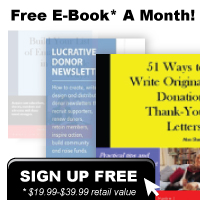If you said: “What are the three most important things in fundraising” you are correct!
In real estate it’s location, location, location. In fundraising it’s list, list, list.
You can have brilliant copy and design but if you use the “wrong” list your mailing will bomb. On the other hand, you can have mediocre copy and design, but if you use the right list, you can still have great results.
It is impossible to overstate the importance of the list. Choosing the list should be the first thing you do for an acquisition mailing. The list you use should influence the nature of the creative. Strategy, copy and design should be tailored to the list. For example, if your list has a lot of seniors, the type size should be larger than average.
Here’s how the right list can generate a great response, with virtually no copy or design. A fishing lodge sends out a postcard to its best customers with just two words: “They’re biting!” The mailing gets a 100% response.
Your best list and the one you can truly rely on is of course your own donor/member list. But there’s a limit as to how many times you can ask your loyal donors for money in a year. Plus no matter how effective your donor retention strategy, some attrition is inevitable. You will lose donors each year, so you must have an ongoing program to replenish and add to your donor base. Also a strategy for lapsed-donor reactivation will usually pay large dividends, even if it has been years since their last gift.
Building and replenishing your list should be an ongoing high-priority project. The goal of gathering names, addresses, phone numbers and email addresses must be top-of-mind at every opportunity and whenever there is an interaction with the public. And remember, every name you collect is valuable until proven otherwise. You never know where your next major donor is coming from.
There are various ways that you can amass a list of names. You can create some kind of a special event and invite the public to attend. You can advertise and offer a free newsletter on your website and on any print materials you produce. You can ask your donor/members, your board members and your staff and volunteers to supply prospect names and/or to recruit members.
In other words, use every method you can to get the names, addresses, etc. of potential donors. And be sure to promise that you will respect their privacy and that you will never sell their information.
Donor lists generally do best. While carefully selected compiled lists can do well, donor lists generally do best.And that makes sense. Someone who already gives to a charity will have a “propensity” to give. That means they will be more likely to give to your charity than someone who does not already give to charity.
Back in an earlier newsletter (#4) the notion of “writing to responders” was discussed as a way to get better response. Mailing to a donor list is doing exactly that – writing/mailing to responders.
And if you can find donor lists that are targeted, they will usually work even better. That’s why you should have an accurate profile of your typical donor – so your list broker or agency can better target.
A good list is an investment that may take time to pay off
Response rates these days can be quite low – anywhere from ½% to 1%. If you can do better than 1% you are doing well. With response rates that low, it is very possible that you will not receive enough revenue in the first mailing to pay the total costs of the mailing. The better your list, the better chance you have of receiving enough funds to cover the cost of the mailing.
But your primary goal in an acquisition mailing should not be to cover the cost of the mailing, If you do, wonderful! If you don’t, no problem. You should view that acquisition mailing as an investment in future revenue. Remember – all those who responded are now your donors. You earned those names and you can mail to them as often as you like.
Each one of those newly acquired donors represents a stream of revenue for your organization – a Lifetime Donor Value. The LDV is important because it gives you revenue parameters to use when you’re evaluating acquisition costs.
Ideally, a list should be tested before rolling out with a large mailing. If you’re a smaller fundraising organization this can be hard to do. To have a reasonably reliable result – a number you can count on when you roll out – the rule of thumb is to have around 50 responses. That means if you’re response rate is in the typical 1% area, you’d need to mail at least 5,000 pieces.
Smaller mailers sometimes try testing smaller amounts. Trouble is, you just can’t rely on the result to repeat on a rollout. Using a small statistically invalid test to make a decision is not much better than flipping a coin. And flipping a coin is a lot easier.




Leave a Reply